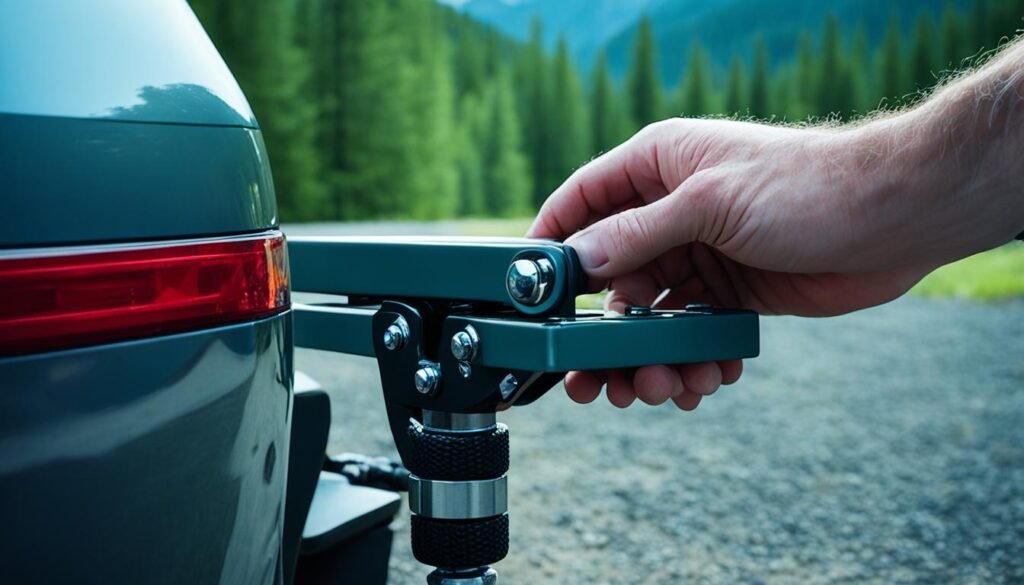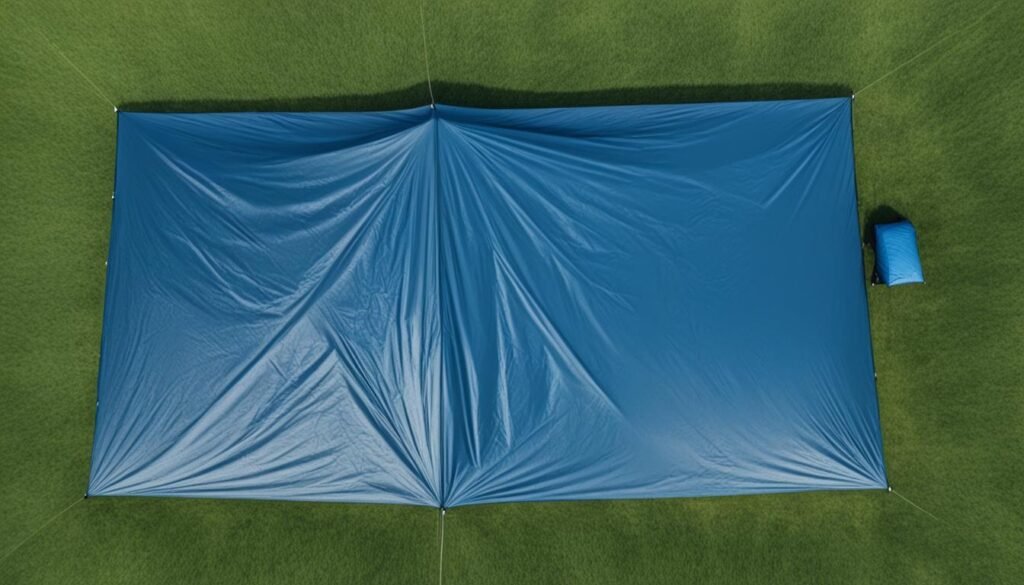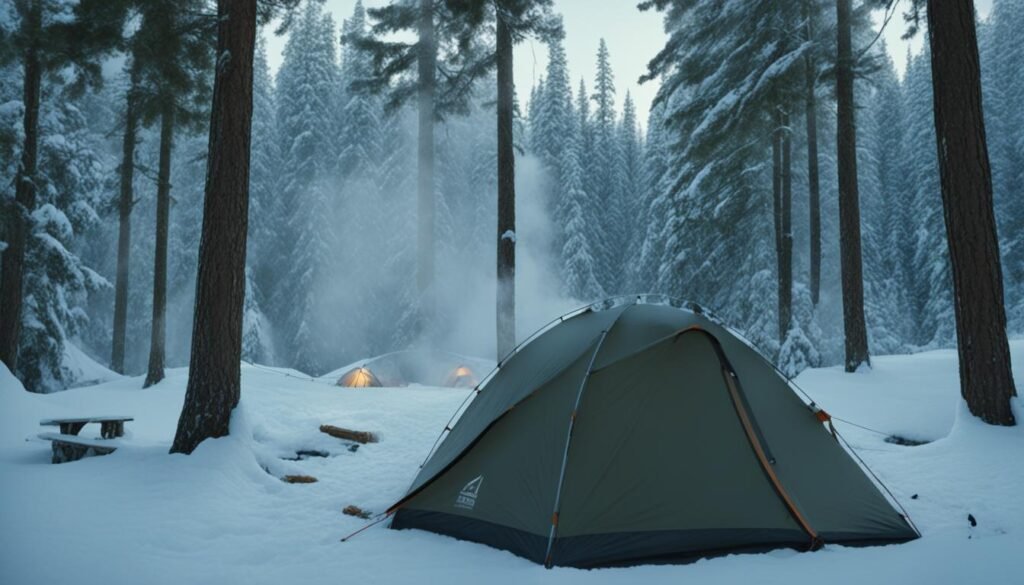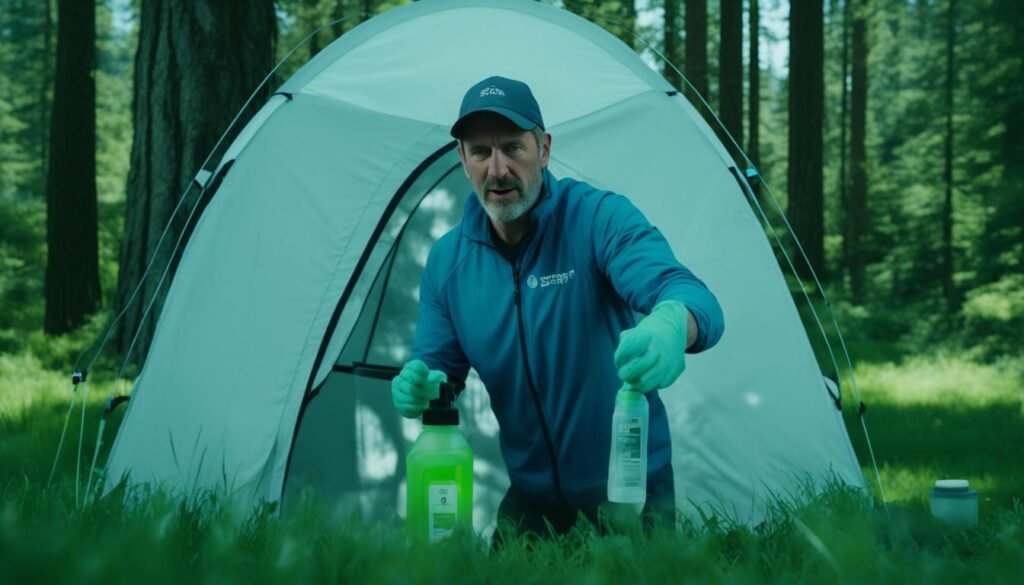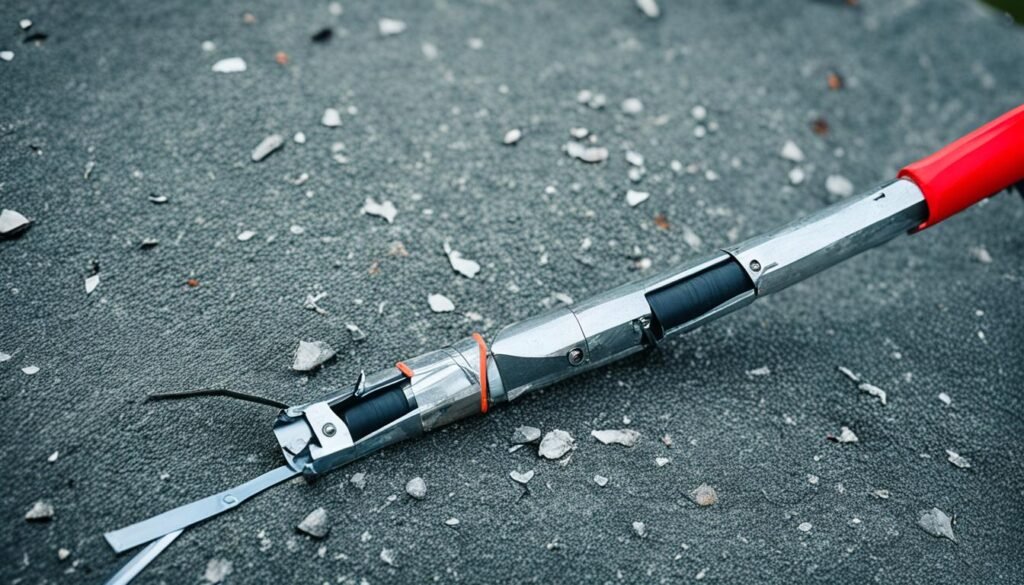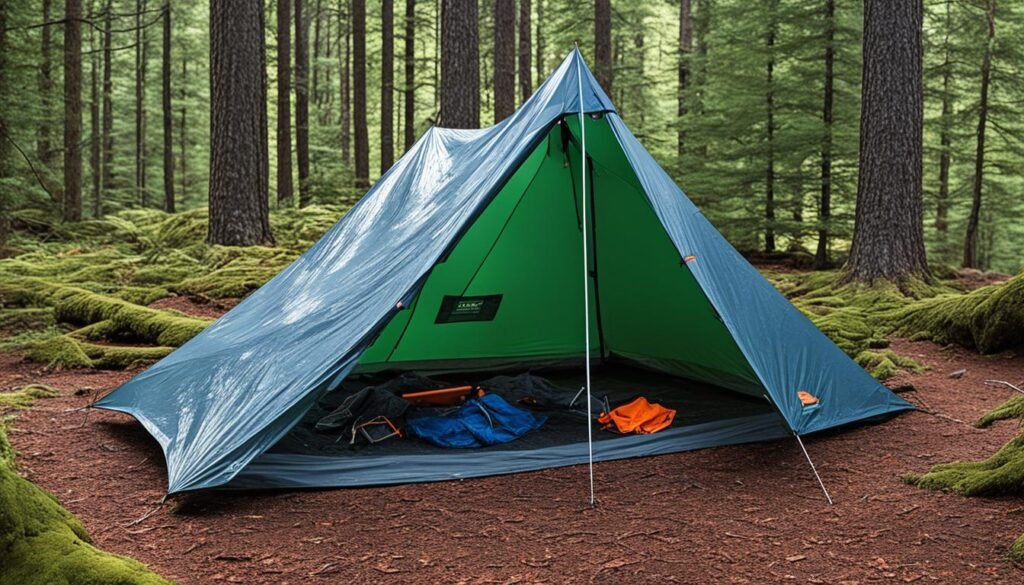When it comes to embarking on a camping adventure with a tent trailer, one of the most crucial steps is properly hitching it to your vehicle. From following the right steps to ensuring a secure connection, hitching a tent trailer requires attention to detail and adherence to best practices. In this comprehensive guide, I will take you through a step-by-step tutorial on how to hitch a tent trailer safely and provide essential tips and tricks for a successful hitching experience.
Key Takeaways:
- Learn the step-by-step process of hitching a tent trailer to your vehicle.
- Understand the different components involved in the hitching process.
- Follow preparatory steps before connecting your tent trailer.
- Master the proper technique of connecting and disconnecting your tent trailer.
- Explore additional tips and best practices for safer and more efficient towing.
Understanding the Hitch Parts: A Breakdown of the Components Involved
Before you begin hitching your tent trailer, it’s essential to understand the different parts involved in the process. Familiarizing yourself with these components will help you navigate the hitching process more efficiently and safely.
Trailer Coupler
The trailer coupler is the mechanism that connects the trailer to the tow vehicle’s hitch. It ensures a secure attachment between the two.
Hitch Latch
The hitch latch is used to secure the trailer coupler in place, preventing it from accidentally unlatching during towing.
Trailer Wiring Harness
The trailer wiring harness provides electrical connections between the tow vehicle and the trailer, allowing for the transfer of signals for lights, brake control, and other electrical components.
Breakaway Cable
The breakaway cable is a safety device that activates the trailer brakes in case the trailer becomes disconnected from the tow vehicle while towing.
Safety Chains
Safety chains provide an additional layer of security by attaching the trailer to the tow vehicle. In the event of a coupler failure, the safety chains keep the trailer connected to the vehicle.
Safety Pin
The safety pin is used to secure certain components, such as the hitch latch, ensuring they remain in their intended position during towing.
Trailer Hitch
The trailer hitch is the part of the tow vehicle that connects to the trailer coupler, allowing for the towing of the trailer.
Receiver Tube
The receiver tube is the opening in the hitch into which the trailer coupler is inserted. It provides a secure connection point for towing.
Ball Mount
The ball mount is the attachment that holds the hitch ball. It allows the trailer coupler to connect to the tow vehicle and provides a pivot point for towing.
| Component | Description |
|---|---|
| Trailer Coupler | The mechanism that connects the trailer to the tow vehicle’s hitch. |
| Hitch Latch | Secures the trailer coupler in place. |
| Trailer Wiring Harness | Provides electrical connections between the tow vehicle and the trailer. |
| Breakaway Cable | Activates the trailer brakes if the trailer becomes disconnected. |
| Safety Chains | Attach the trailer to the tow vehicle, providing additional security. |
| Safety Pin | Secures components, such as the hitch latch. |
| Trailer Hitch | Connects to the trailer coupler, allowing for towing. |
| Receiver Tube | The opening in the hitch to insert the trailer coupler. |
| Ball Mount | Holds the hitch ball and provides a pivot point for towing. |
Preparing for Hitching: Steps to Take Before Connecting Your Tent Trailer
Before you begin the actual hitching process, it’s crucial to prepare your tent trailer and towing vehicle. Taking the time to complete the following steps will ensure a smooth and safe hitching experience.
- Remove the hitch lock: Before you can connect your tent trailer to the towing vehicle, make sure to remove the hitch lock that secures the trailer coupler.
- Position the receiver latch: Align the receiver latch on your towing vehicle with the trailer coupler. It’s important to make sure they are properly aligned to ensure a secure connection.
- Lift the front end of the trailer: Use a trailer jack or tongue jack to lift the front end of the trailer slightly off the ground. This will make it easier to slide the hitch into the receiver.
- Lubricate the jack piston: To ensure smooth operation, apply lubricant to the jack piston. This will make it easier to raise and lower the jack when necessary.
- Check the wheel chocks: Inspect the wheel chocks to ensure they are in good condition and properly positioned. Wheel chocks help prevent the trailer from rolling while hitching or unhitching.
- Handle sway control arms (if applicable): If your tent trailer is equipped with sway control arms, make sure to handle them according to the manufacturer’s instructions. This may involve tightening or releasing tension to ensure proper function.
- Align the vehicles: Properly aligning the towing vehicle and the trailer is crucial for safe towing. Use visual alignment aids or have a second person guide you to achieve proper alignment.
- Use cameras for alignment: If available, utilize backup cameras or other camera systems to assist with alignment. This can provide an additional level of accuracy when aligning the towing vehicle and trailer.
- Attach sway arms (if necessary): If your tent trailer requires sway arms for added stability, attach them securely according to the manufacturer’s instructions.
- Lower the travel trailer: Once all the preparatory steps are completed, carefully lower the travel trailer onto the hitch, ensuring a snug fit.
By following these preparatory steps, you will be ready to proceed with the actual hitching process and ensure a safe and secure connection between your tent trailer and towing vehicle.
Expert Tip:
Before hitching your tent trailer, double-check that you have properly connected and secured all safety components, such as the breakaway cable and safety chains. Taking this extra precaution will provide peace of mind during your journey.
How to Hitch Your Tent Trailer: Step-by-Step Guide
Now that you’re familiar with the different parts involved in hitching a tent trailer and have completed the necessary preparatory steps, it’s time to walk through the actual process of hitching your tent trailer to your vehicle. This step-by-step guide will ensure a smooth and secure connection between your camping home and your towing vehicle. Follow these instructions carefully to avoid any potential issues along the way.
Step 1: Positioning the Hitch
Start by positioning your hitch so that it aligns with the receiver on your vehicle. Make sure the receiver is clean and free from dirt or debris that could interfere with the connection.
Step 2: Sliding the Hitch into the Receiver
With the hitch properly positioned, carefully slide it into the receiver until it reaches the locking mechanism. Ensure that the hitch and receiver are securely engaged.
Step 3: Securing the Locking Pin
Once the hitch is fully inserted into the receiver, secure it in place by inserting the locking pin through the appropriate holes. Make sure the pin is properly seated and secured, preventing any accidental disconnections.
Step 4: Aligning the Vehicles
Aligning your towing vehicle and tent trailer is crucial for safe and stable towing. You can do this by using a friend as a guide or using a camera system specifically designed for trailer hitching. Ensure that the vehicles are aligned straight and center.
Step 5: Attaching Sway Arms (If Applicable)
If your tent trailer is equipped with sway control arms, attach them to the appropriate points on the hitch and trailer frame. Follow the manufacturer’s instructions for proper installation.
Step 6: Lowering the Travel Trailer
Gently lower the front end of your travel trailer, ensuring that it gradually rests on the hitch ball. Take your time during this step to avoid any sudden movements or jarring impacts.
Step 7: Closing the Receiver Latch
Once the travel trailer is securely lowered onto the hitch ball, close the receiver latch to lock it in place. Ensure that the latch is fully engaged and that there is no play or movement.
Step 8: Connecting Brake and Light Cable
Connect the brake and light cable from your travel trailer to the corresponding connectors on your towing vehicle. This will ensure that your trailer’s brakes and lights function properly while towing.
Step 9: Attaching Safety Chains
Attach the safety chains to the appropriate points on your hitch and towing vehicle. Cross them underneath the hitch to form an “X” pattern. This will provide an additional safety measure in case the trailer becomes disconnected from the hitch.
Step 10: Removing Wheel Chocks
Before hitting the road, don’t forget to remove the wheel chocks that were in place to prevent any movement of the trailer during the hitching process. Store them safely in your vehicle for future use.
| Step | Action |
|---|---|
| 1 | Position the hitch in alignment with the receiver |
| 2 | Slide the hitch into the receiver, ensuring a secure connection |
| 3 | Secure the hitch with a locking pin |
| 4 | Align the towing vehicle and trailer |
| 5 | Attach sway control arms (if applicable) |
| 6 | Lower the front end of the trailer onto the hitch ball |
| 7 | Close the receiver latch |
| 8 | Connect the brake and light cable |
| 9 | Attach the safety chains |
| 10 | Remove the wheel chocks |
Unhitching Your Tent Trailer: A Step-by-Step Process
When it’s time to unhitch your tent trailer, following a proper step-by-step process is crucial to ensure a smooth and safe experience. Here’s a detailed guide on unhitching your tent trailer:
Parking in a Safe Spot
Firstly, find a suitable parking spot for your tent trailer. Look for level ground and ensure there is plenty of space around the trailer for maneuvering.
Using Wheel Chocks
Before unhitching, place wheel chocks behind the trailer wheels to prevent any accidental movement.
Lifting the Front of the Trailer
Using the trailer’s jack, lift the front of the trailer slightly off the ground. This relieves pressure on the hitch and makes it easier to unhitch.
Disconnecting Brake Cable, Safety Chains, and Emergency Brake Controller
Next, disconnect the brake cable, safety chains, and emergency brake controller from the towing vehicle. This ensures that the trailer is no longer connected to the vehicle’s braking system.
Removing Sway Bars (if applicable)
If your tent trailer is equipped with sway bars, remove them according to the manufacturer’s instructions. This will allow for easier unhitching.
Lowering the Trailer
Using the trailer jack, lower the trailer back onto its wheels. Make sure it is securely resting on the ground before proceeding.
Lifting the Trailer off the Hitch Ball
Using the trailer jack, carefully lift the trailer off the hitch ball until it is completely detached from the towing vehicle.
Positioning the Trailer
Once the trailer is unhitched, position it as desired in the parking spot. This may involve adjusting its orientation or moving it to a more convenient location.
Storing the Hitch
Finally, properly store the hitch in a secure location, such as a storage compartment or designated hitch storage area, to prevent loss or damage.
Following these step-by-step instructions will help you unhitch your tent trailer safely and efficiently. Always refer to your trailer’s owner’s manual for specific guidelines and consult with professionals if needed.
Continue reading: Tips for Safer Towing: Best Practices and Expert Advice
Exploring Trailer Hitching Tips for Solo Hitching
If you’re hitching your tent trailer solo, there are helpful tips to make the process easier. These tips include using markers or flags for alignment, using the open driver door method for reference, utilizing a backup camera (if available), going slowly, and manually moving the trailer if it’s lightweight enough.
| Tips for Solo Hitching |
|---|
| Use markers or flags for alignment |
| Utilize the open driver door method to gauge distance |
| Take advantage of a backup camera if your vehicle is equipped with one |
| Go slowly to ensure precision |
| If possible, manually move the trailer to fine-tune its position |
Hitching a tent trailer solo may seem daunting, but with these trailer hitching tips, you can confidently connect your trailer to your vehicle without any assistance. Using markers or flags for alignment allows you to visually guide yourself, ensuring a proper connection. Another helpful method is the open driver door method, which helps you gauge the distance between your vehicle and the trailer. Many modern vehicles come with backup cameras, which can be utilized to make hitching even easier. It’s crucial to go slowly during the hitching process to ensure precision and avoid any mishaps. If your trailer is lightweight enough, manually moving it by pushing or pulling can make necessary adjustments effortless.
Remember, practicing these trailer hitching tips and techniques will enhance your solo hitching experience, giving you the confidence and skills to connect your tent trailer safely and efficiently.
Understanding the Importance of Safety Measures: Safety Chains and Breakaway Cable
Safety is of utmost importance when it comes to towing a tent trailer. To ensure a secure and worry-free towing experience, two critical safety measures should never be overlooked: safety chains and a breakaway cable. Properly understanding the importance of safety chains, their function, and ensuring their proper attachment is crucial for the overall safety of your towing setup. Additionally, comprehending the purpose of a breakaway cable and how it enhances safety during towing is essential.
The Role of Trailer Wiring Harness: Ensuring Proper Lighting and Signals
When it comes to safely towing your tent trailer, the role of the trailer wiring harness cannot be overlooked. This essential component ensures proper lighting and signals between your trailer and the towing vehicle, enhancing safety on the road.
The trailer wiring harness connects directly to the vehicle’s wiring system, allowing for seamless communication between the two. It typically features either a 7-pin round connector or a 4-way flat plug, depending on the trailer’s electrical requirements.
Regularly checking the functionality of the trailer lights, brake lights, and turn signals is crucial for ensuring optimal safety while towing. This can be done by simply connecting the wiring harness to the tow vehicle and conducting a visual inspection to ensure all lights are functioning correctly.
By maintaining a properly working trailer wiring harness, you can have peace of mind knowing that other motorists can see your trailer’s lighting signals, making lane changes and turns safer for everyone on the road.
The Importance of Checking Trailer Lights
Checking the trailer lights should be part of your routine pre-tow inspection. Here’s a simple step-by-step guide to ensure proper functionality:
- Start by connecting the trailer wiring harness to the tow vehicle.
- Inspect the brake lights to verify that they illuminate when the brake pedal is pressed.
- Check the turn signals on both the trailer’s left and right sides to ensure they are functioning correctly.
- Inspect the tail lights to ensure they illuminate when the headlights are turned on.
- Finally, verify that the trailer’s hazard lights are working by activating them and observing their functionality.
By following this simple checklist, you can identify any issues with the trailer lights and address them promptly, ensuring safer travels with your tent trailer.
| Trailer Light | Functionality |
|---|---|
| Brake Lights | Illuminate when brake pedal is pressed |
| Turn Signals | Working on both left and right sides |
| Tail Lights | Illuminate when headlights are turned on |
| Hazard Lights | Activate and observe functionality |
Ensuring the proper functioning of your trailer lights is essential for safe and legal towing. By regularly checking and maintaining your trailer wiring harness, you can enjoy worry-free travels with your tent trailer, knowing that your lighting signals are visible to other drivers on the road.
The Benefits of Using a Weight Distribution Hitch
When it comes to towing a tent trailer, using a weight distribution hitch offers a range of benefits that contribute to a safer and more efficient towing experience. One of the key advantages of a weight distribution hitch is its ability to distribute the weight evenly across both the trailer and the tow vehicle.
Distributing the weight evenly is crucial as it helps prevent trailer sway and bounce, which can negatively impact stability and control on the road. By ensuring that the weight is properly distributed, a weight distribution hitch enhances towing performance and minimizes the risk of accidents or mishaps.
Improved stability is particularly important when towing larger or heavier tent trailers. The even weight distribution prevents the trailer from swaying side to side or bouncing excessively, maintaining a smoother and more predictable towing experience. This stability not only enhances safety but also provides a more comfortable ride for both the driver and passengers.
In addition to stability, a weight distribution hitch also helps improve control while towing. By evenly distributing the weight, it reduces the strain on the tow vehicle’s suspension, tires, and brakes. This ensures that the tow vehicle operates within its intended capacity, allowing for better maneuverability and braking efficiency.
Furthermore, a weight distribution hitch can help mitigate the potential for wear and tear on both the trailer and the tow vehicle. By evenly distributing the weight, it prevents excessive strain on specific areas, reducing the risk of damage and extending the lifespan of the towing components.
Overall, using a weight distribution hitch provides numerous benefits in terms of safety, efficiency, and longevity. Whether you’re towing a small tent trailer or a larger model, incorporating a weight distribution hitch into your setup is a wise investment that contributes to a smoother, more controlled, and enjoyable towing experience.

Key Benefits of Using a Weight Distribution Hitch
| Benefit | Description |
|---|---|
| Enhanced Safety | Prevents trailer sway and bounce, promoting stability and control while towing. |
| Improved Towing Efficiency | Evenly distributes weight, reducing strain on the tow vehicle and enhancing maneuverability. |
| Extended Lifespan | Reduces wear and tear on the trailer and tow vehicle, prolonging their lifespan. |
| Smooth and Comfortable Ride | Minimizes bouncing and provides a more predictable towing experience for driver and passengers. |
Pre-Towing Checklist: Ensuring Everything is Set for a Smooth Journey
Before embarking on your journey with your hitched tent trailer, it’s important to go through a pre-towing checklist. This checklist includes ensuring the trailer ball matches the coupler size, properly torquing the ball, securing the ball mount, latching the coupler, retracting the trailer jack, securely attaching safety chains, checking the functioning trailer lights, and verifying the working brake controller.
Pre-Towing Checklist:
- Check the trailer ball and coupler size to ensure a proper match.
- Make sure the ball is properly torqued to the manufacturer’s specifications.
- Secure the ball mount to the towing vehicle hitch receiver.
- Ensure the coupler is latched securely onto the hitch ball.
- Retract the trailer jack to its proper travel position.
- Attach the safety chains to the towing vehicle, crossing them for added security.
- Check that the trailer lights are functioning properly.
- Verify that the brake controller is working correctly.
By completing this pre-towing checklist, you can ensure that everything is set for a smooth and safe journey with your tent trailer. Taking the time to perform these checks will provide you with peace of mind and help prevent any potential issues during your travels.
Tips for Safer Towing: Best Practices and Expert Advice
To ensure a safe and worry-free towing experience with your tent trailer, it’s important to follow best practices and expert advice. By implementing these tips, you can enhance the safety and performance of your towing setup.
Distribute Weight Correctly
Properly distributing weight between your vehicle and tent trailer is crucial for safe towing. Make sure to load heavier items towards the front and center of the trailer and avoid placing excessive weight at the back. Distributing weight evenly helps maintain stability and reduces the risk of trailer sway.
Maintain Proper Tire Pressure
Regularly check and maintain the tire pressure of both your towing vehicle and tent trailer. Underinflated tires can lead to reduced control, increased fuel consumption, and premature tire wear. Refer to the manufacturer’s recommendations for the correct tire pressure and check them before every trip.
Adjust Brake Control
Ensure that your brake control system is properly adjusted to provide efficient braking power for your tent trailer. This adjustment allows the trailer’s brakes to engage at the correct intensity, improving braking performance and reducing stopping distances. Consult your vehicle’s owner’s manual or seek professional assistance for adjusting the brake control system.
Regular Maintenance and Inspections
Maintaining a regular maintenance schedule for your tent trailer is vital for its longevity and safe operation. Regularly inspect and service all components, including the hitch, brakes, lights, suspension, and tires. This preventative maintenance will help prevent potential issues and ensure your towing setup is always in optimal condition.
“By following these tips, you can have peace of mind knowing that you are towing your tent trailer safely and responsibly. Be proactive in maintaining your equipment and always prioritize safety.”
Remember, towing a tent trailer safely requires careful attention to detail and adherence to best practices. By distributing weight correctly, maintaining proper tire pressure, adjusting brake control, and conducting regular maintenance and inspections, you can enjoy worry-free adventures with your tent trailer.
Destination Ideas for Your Towing Adventure: Scenic Routes and Campgrounds
Now that you’re ready for your towing adventure, it’s time to explore some destination ideas. Consider taking scenic routes and visiting campgrounds along the way. From America’s most scenic routes to camping in the Blue Ridge Mountains and exploring California’s Lost Coast, there are endless possibilities for memorable trips with your tent trailer.
Embark on a breathtaking journey across America’s most scenic routes. Drive along the iconic Pacific Coast Highway in California and witness stunning coastal vistas. Discover the awe-inspiring beauty of the Blue Ridge Parkway as you wind through the Blue Ridge Mountains, marveling at the vibrant autumn foliage.
For a unique camping experience, head to the Blue Ridge Mountains campground, nestled amidst picturesque landscapes and offering excellent hiking trails. Set up camp in the heart of nature, surrounded by towering trees and tranquil streams.
If you’re seeking a coastal camping adventure, explore California’s Lost Coast. This remote and rugged stretch of coastline promises breathtaking views and untouched wilderness. Camp along the shore, fall asleep to the sound of crashing waves, and wake up to stunning sunrises.
Whether you prefer mountains, coastal vistas, or something in between, the United States offers an array of destination ideas for your towing adventure. Select a scenic route, find a nearby campground, and let the beauty of nature immerse you during your tent trailer journey.
| Scenic Route | Location |
|---|---|
| Pacific Coast Highway | California |
| Blue Ridge Parkway | Blue Ridge Mountains |
| Campground | Location |
|---|---|
| Blue Ridge Mountains Campground | Blue Ridge Mountains |
| California’s Lost Coast Campground | California |
Personalize Your Towing Experience: Tips to Tailor your Tent Trailer Setup
When it comes to towing your tent trailer, personalization is key. Transforming your temporary home on wheels into a comfortable and functional space can greatly enhance your camping adventures. In this section, I will provide you with tips and ideas to personalize your tent trailer setup, ensuring it meets your unique needs and preferences.
Customization Options
To begin personalizing your tent trailer, explore the wide range of customization options available. Consider upgrading features such as the interior layout, flooring, upholstery, and cabinetry to suit your style and comfort requirements. Many manufacturers offer customization packages, allowing you to choose from various design options and materials.
“Customizing your tent trailer not only adds a personal touch, but it also increases its value and appeal.”
Adding Accessories
Enhance the functionality and versatility of your tent trailer by adding accessories. Invest in awnings, portable grills, camping chairs, and tables to create an outdoor living space. Install bike racks, kayak carriers, or cargo boxes to accommodate your recreational equipment. These accessories not only make your camping experience more enjoyable but also allow you to make the most of your outdoor adventures.
Organizing Storage Space
An organized storage space is essential for a clutter-free tent trailer. Utilize storage bins, collapsible containers, and hanging organizers to keep your belongings neatly arranged. Maximize vertical space by using stackable storage solutions. Consider adding storage compartments or racks to the exterior of your trailer for additional storage options.
Creating a Comfortable Interior
A comfortable interior is key to a relaxing camping experience. Invest in quality mattresses, bedding, and pillows to ensure a good night’s sleep. Install window coverings or curtains to control lighting and temperature. Consider adding insulation or soundproofing materials to enhance comfort and privacy.
Don’t forget about the little details that can make a big difference. Incorporate cozy rugs, decorative pillows, and lighting fixtures that create a warm and inviting atmosphere. Adding personal touches such as photos, artwork, or plants can also make your tent trailer feel more like home.

Personalizing your tent trailer setup allows you to create a space that reflects your style and caters to your camping needs. By exploring customization options, adding accessories, organizing storage space, and creating a comfortable interior, you can make your towing experience truly unique and enjoyable.
Troubleshooting Common Hitching Issues: Troubleshooting Guide
During the hitching process, it’s not uncommon to encounter a few challenges that may require troubleshooting. These issues can include trailer misalignment, difficulty latching the coupler, or hitch ball clearance problems. In this troubleshooting guide, I will provide you with steps to help identify and overcome these common hitching issues for a successful towing experience.
1. Trailer Misalignment
If you find that your trailer is not aligning properly with your vehicle, follow these steps:
- Ensure that both the towing vehicle and the trailer are on level ground.
- Use visual markers or alignment flags to assist in aligning the trailer with the hitch.
- If possible, ask a friend or use a backup camera to guide you in aligning the trailer properly.
2. Difficulty Latching the Coupler
If you’re having trouble latching the coupler onto the hitch ball, try the following troubleshooting steps:
- Make sure the coupler is fully open and ready to receive the hitch ball.
- Inspect the hitch ball for proper alignment and make any necessary adjustments.
- Ensure that the coupler latch mechanism is functioning correctly and not obstructed.
- Apply a lubricant to the coupler mechanism if needed.
3. Hitch Ball Clearance Issues
When hitching your trailer, it’s important to have proper hitch ball clearance. If you’re experiencing clearance issues, follow these troubleshooting steps:
- Ensure that the hitch ball size matches the coupler size on your trailer.
- Check that the hitch ball is properly secured and torqued to the appropriate specifications.
- If clearance is still an issue, consider using a different ball mount with the appropriate rise or drop.
Note: It’s worth mentioning that if you find yourself struggling with any of these hitching issues, seeking professional assistance or contacting the manufacturer for guidance might be beneficial. Your safety and the safety of others on the road should always be the top priority.
By following these troubleshooting steps, you’ll be well-equipped to handle common hitching issues and ensure a smooth and secure towing experience. Remember to always take your time, stay focused, and prioritize safety.
Tips for Proper Storage and Maintenance of Your Hitch and Trailer
Proper storage and maintenance are crucial for ensuring the longevity and optimal performance of your hitch and tent trailer. By following these tips, you can keep your equipment in top shape and enjoy worry-free camping adventures:
- Cleaning the Hitch: Regularly remove dirt, grime, and debris from your hitch using a mild soap and water solution. Scrub any rust spots gently with a wire brush and apply a rust inhibitor to prevent further corrosion.
- Inspecting Safety Components: Check the safety components of your hitch, such as the trailer coupler, safety chains, and breakaway cable, for any signs of wear or damage. Replace any worn-out or broken parts immediately to maintain optimal safety.
- Lubricating Moving Parts: Apply lubricant to the moving parts of your hitch, such as the ball mount and receiver tube, to ensure smooth and friction-free operation. This will prevent wear and tear and extend the lifespan of these components.
- Preventing Rust and Corrosion: Protect your hitch and trailer from rust and corrosion by applying a high-quality wax or corrosion inhibitor. This will create a protective barrier against moisture and environmental elements.
Remember, proper maintenance and care are key to extending the lifespan of your hitch and trailer.
By following these storage and maintenance tips, you can keep your hitch and trailer in excellent condition, ensuring safe and enjoyable camping experiences for years to come.
Hitch and Trailer Maintenance Checklist
| Task | Frequency | Notes |
|---|---|---|
| Clean the hitch | Before and after each trip | Use mild soap and water to remove dirt and debris |
| Inspect safety components | Before each trip | Check for wear, damage, or corrosion |
| Lubricate moving parts | Every 6 months or as needed | Apply lubricant to ball mount, receiver tube, etc. |
| Prevent rust and corrosion | Annually or as needed | Apply wax or corrosion inhibitor |
Use this checklist as a reference to keep track of your hitch and trailer maintenance tasks. Regularly performing these tasks will help you catch potential issues early and ensure a smooth and reliable towing experience.
What Are the Safety Tips for Hitching a Rooftop Tent Trailer to Your Vehicle?
When hitching a rooftop tent trailer to your vehicle, it’s important to use proper techniques for lifting rooftop tent to avoid injury. Always ensure the trailer’s hitch and your vehicle’s receiver are compatible, and double-check the connections before hitting the road. Properly secure the tent and trailer to prevent any accidents on the road.
Conclusion
In conclusion, successfully hitching a tent trailer requires following proper procedures and paying attention to detail. By understanding the components involved, following step-by-step guides, and implementing safety measures, you can ensure a safe and secure hitching experience.
Throughout this guide, we have emphasized the importance of following proper hitching procedures to avoid costly mistakes and ensure the safety of yourself, your passengers, and others on the road. From preparing for hitching to the actual hitching process and post-towing maintenance, every step is crucial.
Remember to always follow best practices, such as properly positioning the hitch, aligning the vehicles, attaching sway arms (if necessary), and securing safety chains and the brake and light cable. Regularly inspecting and maintaining your hitch and trailer will also contribute to optimal performance.
By following these guidelines and taking the time to learn and practice proper hitching procedures, you can enjoy your towing adventures with peace of mind, knowing that you have done everything possible to ensure a safe and enjoyable experience. Happy towing!
FAQ
What are the different parts involved in hitching a tent trailer?
The different parts involved in hitching a tent trailer include the trailer coupler, hitch latch, trailer wiring harness, breakaway cable, safety chains, safety pin, trailer hitch, receiver tube, and ball mount.
What preparatory steps should I take before hitching my tent trailer?
Before hitching your tent trailer, you should remove the hitch lock, position the receiver latch, lift the front end of the trailer, lubricate the jack piston, check the wheel chocks, handle sway control arms (if applicable), align the vehicles, use cameras for alignment, attach sway arms (if necessary), and lower the travel trailer.
How do I hitch my tent trailer to my vehicle?
To hitch your tent trailer to your vehicle, you need to position the hitch, slide the hitch into the receiver, secure the locking pin, align the vehicles, use friends or a camera for alignment, attach sway arms (if applicable), lower the travel trailer, close the receiver latch, connect the brake and light cable, attach the safety chains, and remove the wheel chocks.
What is the process for unhitching a tent trailer?
The process for unhitching a tent trailer includes parking the trailer in a safe spot, using wheel chocks, lifting the front of the trailer, disconnecting the brake cable, safety chains, and emergency brake controller, removing sway bars (if applicable), lowering the trailer, lifting the trailer off the hitch ball, positioning the trailer, and storing the hitch properly.
Are there any tips for solo hitching a tent trailer?
Yes, some helpful tips for solo hitching a tent trailer include using markers or flags for alignment, using the open driver door method for reference, utilizing a backup camera (if available), going slowly, and manually moving the trailer if it’s lightweight enough.
What are the important safety measures when towing a tent trailer?
Two important safety measures when towing a tent trailer are safety chains and a breakaway cable. Safety chains should be properly attached and serve as a backup connection in case the trailer separates from the vehicle. The breakaway cable activates the trailer brakes automatically if the trailer becomes disconnected from the towing vehicle.
What is the role of the trailer wiring harness?
The trailer wiring harness ensures proper lighting and signals between your tent trailer and the towing vehicle. It connects to the vehicle’s wiring and typically features a 7-pin round connector or a 4-way flat plug. Regularly checking the trailer lights, brake lights, and turn signals is essential for safe towing.
What are the benefits of using a weight distribution hitch?
Using a weight distribution hitch promotes safer and more efficient towing. It distributes the weight evenly across the trailer and tow vehicle, helping to prevent trailer sway and bounce. This enhances stability and control on the road.
What should I include in my pre-towing checklist?
In your pre-towing checklist, you should ensure that the trailer ball matches the coupler size, the ball is properly torqued, the ball mount is securely attached, the coupler is latched, the trailer jack is retracted, the safety chains are securely attached, the trailer lights are functioning, and the brake controller is working.
Any tips for safer towing?
Yes, some tips for safer towing include distributing weight correctly, maintaining proper tire pressure, adjusting the brake control properly, and conducting regular maintenance and inspections to keep your towing setup in optimal condition.
Are there any destination ideas for my towing adventure?
Absolutely! Consider taking scenic routes and visiting campgrounds along the way. From America’s most scenic routes to camping in the Blue Ridge Mountains and exploring California’s Lost Coast, there are endless possibilities for memorable trips with your tent trailer.
How can I personalize my tent trailer setup?
You can personalize your tent trailer setup by exploring customization options and adding accessories to enhance functionality and comfort. Organize the storage space efficiently and create a comfortable interior that suits your camping style and preferences.
What should I do if I encounter common hitching issues?
If you encounter common hitching issues such as trailer misalignment, difficulty latching the coupler, or hitch ball clearance issues, refer to the troubleshooting guide provided to help you identify and overcome these challenges for a successful hitching experience.
How should I store and maintain my hitch and trailer?
To ensure the longevity and performance of your hitch and trailer, you should clean the hitch, inspect safety components, lubricate moving parts, and prevent rust and corrosion by following the provided tips for storage and maintenance.

